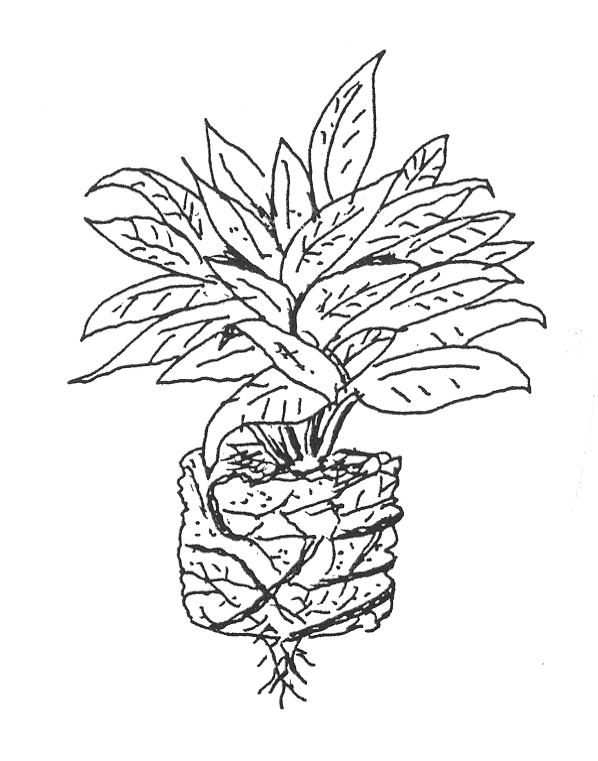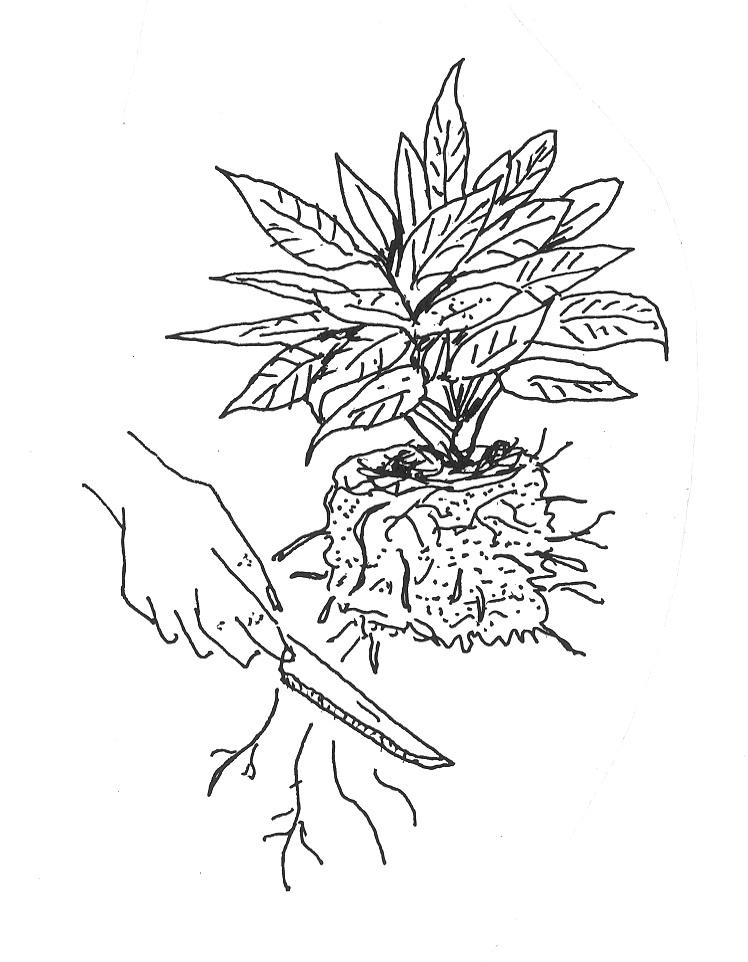Steps for potting or repotting an indoor plant
1. Place a shard over the drainage hole to prevent leakage of soil. Don’t fill the bottom of your pot with gravel. Over the shard, place enough new potting mix in the bottom of the pot to raise the root ball to an inch or two below the new pot’s rim, allowing enough head room for watering.
2. Remove the plant from its old pot by knocking the container against a hard surface. Tilt the pot upside-down. Gently pull the plant from the pot, with your hand over the soil. Using clean, sharp scissors cut horizontally down the root ball about a half-inch into the healthy roots at two- to three-inch intervals. Remove any dead, brown roots.


3. Place the plant into the new pot, filling soil around the root ball, gently tamping it in with your fingers to eliminate air pockets.
4. Water thoroughly but avoid further watering until the soil dries at the top.
About potting medium (soil)
The potting medium should be porous for root aeration and drainage but also be able to retain water and nutrients. Most commercially prepared mixes are termed artificial, meaning they contain no soil. Some key points to remember are:
-
Avoid purchase of products described as “potting soil.” They are usually too dense to allow for proper aeration. If you purchase potting soil, you will need to add vermiculite or perlite to loosen the soil and make it more friable;
-
Buy an artificial, soil-less mixture. These contain a combination of peat moss, vermiculite, and perlite; and
-
High-quality artificial mixes contain slow-release fertilizers which will meet a plant’s nutritional requirements for several months.
Choose the right potting medium for your plant
The potting medium you buy should have the most efficient combination of elements for the type of plant you want to grow. Houseplant media can be divided into four groups, each of which has slightly different characteristics.
Foliage Plants
-
Potting medium should be moderately rich, have a loamy base and hold moisture and fertility adequately; and
-
Mix about one teaspoon of superphosphate fertilizer per quart of mix to encourage good root growth.
Flowering Indoor Plants
-
Generally used for African violets, gloxinias, begonias, calla lilies, and other tropical houseplants;
-
It is often labeled and sold as “African violet potting mix”;
-
Should contain about 50 percent humus-rich materials, but not to the point that it is soggy after watering; and
-
You should add one teaspoon of superphosphate fertilizer per quart of mixture.
Cacti and Succulents
-
Do not need as much humus material; and
-
A high proportion of sand should be present in purchased mix.
Orchid Mix
-
Epiphytes or air plants (orchids, bromeliads, and anthuriums) don’t grow in the ground; in nature their roots attach to tree branches. If they are grown in regular potting mix, their roots may rot;
-
They should be grown in a mix of very porous, lumpy material that does not retain water very long;
-
A common mix is one part peat moss, six parts fir bark, and one part medium grade charcoal. A non-bark mix is made from charcoal, perlite, and a premium potting mix.
Containers
Handsome containers improve the appearance of plants, especially large floor plants. There are many pots on the market; each type has good and bad qualities.
Terra cotta clay pots
Easily absorb and lose moisture, provide excellent aeration for plant roots, encourage good root growth and roots spread out to grow near the pot's walls because moisture and nutrients accumulate in the clay pores. But the negatives are: they dry out rapidly, are easily broken, and are not flexible making it difficult the remove a plant.
Ceramic pots
Are usually glazed, so they retain moisture longer, are attractive and aesthetically pleasing. But they chip and break easily and commonly lack sufficient drainage holes (but can be used with a clay or plastic pot inside to allow for drainage),
Plastic or fiberglass containers
Are lightweight and easy to handle, relatively inexpensive, easy to clean and sterilize for reuse and plants require less frequent watering and accumulate fewer soluble salts. But they occasionally lack drainage holes, can fade in bright sunlight and may become brittle if left outside in cold weather.
